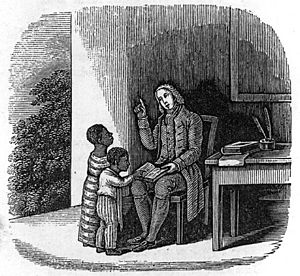Anthony Benezet facts for kids
Quick facts for kids
Anthony Benezet
|
|
|---|---|

"Benezet instructing colored children"
Illustration by John Warner Barber in a book from 1850 |
|
| Born |
Antoine Bénézet
January 31, 1713 Saint-Quentin, Aisne, France
|
| Died | May 3, 1784 (aged 71) Philadelphia, U.S.
|
| Nationality | French-American |
| Occupation | Teacher |
| Known for | Advocacy for abolition |
|
Pennsylvania Historical Marker
|
|
| Official name | Anthony Benezet (1713–1784) |
| Type | City |
| Criteria | African American, Education, Religion, Women, Writers |
| Designated | June 04, 2016 |
| County | Philadelphia |
| Location | 325 Chestnut St., Philadelphia 39°56′57″N 75°08′50″W / 39.94904°N 75.14721°W |
Anthony Benezet (born Antoine Bénézet on January 31, 1713 – died May 3, 1784) was a French-American teacher. He was a very important person in Philadelphia, Pennsylvania. Anthony Benezet was one of the first people in America to speak out against slavery. People who wanted to end slavery were called abolitionists.
He started one of the world's first groups to fight slavery. This group was called the Society for the Relief of Free Negroes Unlawfully Held in Bondage. After he died, it became the Pennsylvania Abolition Society. Benezet also opened the first public school for girls in North America. He also founded the Negro School at Philadelphia for Black children. This school helped many students for a long time. Anthony Benezet was also a vegetarian. He believed in treating animals kindly and taught this idea to his students.
Contents
Anthony Benezet's Early Life and Family
Antoine Bénézet was born in Saint-Quentin, Aisne, France. His parents were Jean-Étienne de Bénézet and Judith de la Méjanelle. They were Huguenots, which means they were French Protestants. At that time, Huguenots were treated badly in France. They faced attacks and were not allowed to practice their religion freely.
In 1715, Antoine's family had their belongings taken away. So, they decided to leave France to keep their religious beliefs. They first moved to Rotterdam and then briefly to Greenwich. Finally, they settled in London, England. Many other Huguenot families also found safety in London. In 1727, Benezet joined the Religious Society of Friends, also known as Quakers.
Moving to America and Fighting Slavery
In 1731, when Anthony was 18, his family moved to Philadelphia, Pennsylvania. Philadelphia was founded by Quakers and was one of the English colonies in North America. Anthony Benezet became one of the first American abolitionists, working alongside John Woolman. Like Woolman, Benezet also believed people should not pay taxes that supported wars.
In 1736, Anthony Benezet married Joyce Marriott. In Philadelphia, he worked hard to convince other Quakers that owning enslaved people was wrong. He believed it did not fit with Christian teachings. He thought the ban on slavery in Britain should also apply to the American colonies. Even after America became independent, Benezet kept pushing for slavery to end. Pennsylvania passed a law in 1780 to slowly end slavery.
Anthony Benezet's Schools
After trying to be a merchant and not succeeding, Benezet started teaching in 1739. He taught at a school in Germantown, Philadelphia, which was a town near Philadelphia. In 1742, he moved to the Friends' English School of Philadelphia. This school is now known as the William Penn Charter School. By 1750, he even added night classes for enslaved Black people.
In 1755, Benezet left the Friends' English School. He opened his own school, which was very special. It was the first public school for girls on the American continent. Important families sent their daughters to his school, including Deborah Norris and Sally Wister.
In 1770, he started another important school. This was the Negro School at Philadelphia, created for Black children. Philadelphia had a growing community of free Black people. This community grew even more after Pennsylvania started to end slavery. Other abolitionists, like Abigail Hopper Gibbons, continued to teach at Benezet's school for many years.
Starting the First Anti-Slavery Group
In 1775, Anthony Benezet helped create the first anti-slavery group. It was called the Society for the Relief of Free Negroes Unlawfully Held in Bondage. Eight years later, in 1783, Benezet wrote a letter to Queen Charlotte of Mecklenburg-Strelitz. In his letter, he talked about how cruel slavery was and how much he opposed the slave trade.
After Benezet passed away, important figures like Benjamin Franklin and Dr. Benjamin Rush restarted this group. It became known as the Pennsylvania Abolition Society.
Anthony Benezet's Legacy
Anthony Benezet's work continued to inspire others. In 1817, an abolitionist named Roberts Vaux wrote a book about Benezet's life. This book helped share Benezet's important message and actions with more people.
Anthony Benezet's Writings
Anthony Benezet wrote several books and pamphlets to share his ideas. He wanted to show people why slavery was wrong and how it harmed others. His writings helped to spread the anti-slavery message.
- Observations on the inslaving [sp], importing and purchasing of Negroes. (1760)
- A short account of that part of Africa inhabited by the negroes (1762)
- A Caution and Warning to Great Britain and her Colonies (1767)
- Some Historical Account of Guinea (1771)
See also

